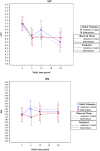Nurse-led behavioral management of diabetes and hypertension in community practices: a randomized trial
- PMID: 25567758
- PMCID: PMC4395596
- DOI: 10.1007/s11606-014-3154-9
Nurse-led behavioral management of diabetes and hypertension in community practices: a randomized trial
Abstract
Background: Several trials have demonstrated the efficacy of nurse telephone case management for diabetes (DM) and hypertension (HTN) in academic or vertically integrated systems. Little is known about the real-world potency of these interventions.
Objective: To assess the effectiveness of nurse behavioral management of DM and HTN in community practices among patients with both diseases.
Design: The study was designed as a patient-level randomized controlled trial.
Participants: Participants included adult patients with both type 2 DM and HTN who were receiving care at one of nine community fee-for-service practices. Subjects were required to have inadequately controlled DM (hemoglobin A1c [A1c] ≥ 7.5%) but could have well-controlled HTN.
Interventions: All patients received a call from a nurse experienced in DM and HTN management once every two months over a period of two years, for a total of 12 calls. Intervention patients received tailored DM- and HTN- focused behavioral content; control patients received non-tailored, non-interactive information regarding health issues unrelated to DM and HTN (e.g., skin cancer prevention).
Main outcomes and measures: Systolic blood pressure (SBP) and A1c were co-primary outcomes, measured at 6, 12, and 24 months; 24 months was the primary time point.
Results: Three hundred seventy-seven subjects were enrolled; 193 were randomized to intervention, 184 to control. Subjects were 55% female and 50% white; the mean baseline A1c was 9.1% (SD = 1%) and mean SBP was 142 mmHg (SD = 20). Eighty-two percent of scheduled interviews were conducted; 69% of intervention patients and 70% of control patients reached the 24-month time point. Expressing model estimated differences as (intervention--control), at 24 months, intervention patients had similar A1c [diff = 0.1 %, 95 % CI (-0.3, 0.5), p = 0.51] and SBP [diff = -0.9 mmHg, 95% CI (-5.4, 3.5), p = 0.68] values compared to control patients. Likewise, DBP (diff = 0.4 mmHg, p = 0.76), weight (diff = 0.3 kg, p = 0.80), and physical activity levels (diff = 153 MET-min/week, p = 0.41) were similar between control and intervention patients. Results were also similar at the 6- and 12-month time points.
Conclusions: In nine community fee-for-service practices, telephonic nurse case management did not lead to improvement in A1c or SBP. Gains seen in telephonic behavioral self-management interventions in optimal settings may not translate to the wider range of primary care settings.
Figures
Comment in
-
Capsule commentary on Edelman et al., Nurse-led behavioral management of diabetes and hypertension in community practices: a randomized trial.J Gen Intern Med. 2015 May;30(5):653. doi: 10.1007/s11606-015-3207-8. J Gen Intern Med. 2015. PMID: 25666217 Free PMC article. No abstract available.
References
-
- The CDC Diabetes Cost Effectiveness group. Cost-effectiveness of intensive glycemic control, intensified hypertension control, and serum cholesterol level reduction for type 2 diabetes. JAMA. 2002;287:2542–51. - PubMed
-
- Hansson L, Zanchetti A, Carruthers SG, Dahlof B, Elmfeldt D, Julius S, Menard J, Rahn KH, Wedel H, Westerling S. Effects of intensive blood-pressure lowering and low-dose aspirin in patients with hypertension: principal results of the Hypertension Optimal Treatment (HOT) randomised trial. Lancet. 1998;351(9118):1755–1762. doi: 10.1016/S0140-6736(98)04311-6. - DOI - PubMed
-
- Estacio RO, Jeffers BW, Gifford N, Schrier RW. Effect of blood pressure control on diabetic microvascular complications in patients with hypertension and type 2 diabetes. Diabetes Care. 2000;23(S2):B54–B64. - PubMed
-
- Adler AI, Stratton IM, Neil HA, Yudkin JS, Matthews DR, Cull CA, Wright AD, Turner RC, Holman RR. Association of systolic blood pressure with macrovascular and microvascular complications of type 2 diabetes (UKPDS 36): prospective observational study. BMJ. 2000;321(7258):412–419. doi: 10.1136/bmj.321.7258.412. - DOI - PMC - PubMed
Publication types
MeSH terms
Grants and funding
LinkOut - more resources
Full Text Sources
Other Literature Sources
Medical
Miscellaneous



